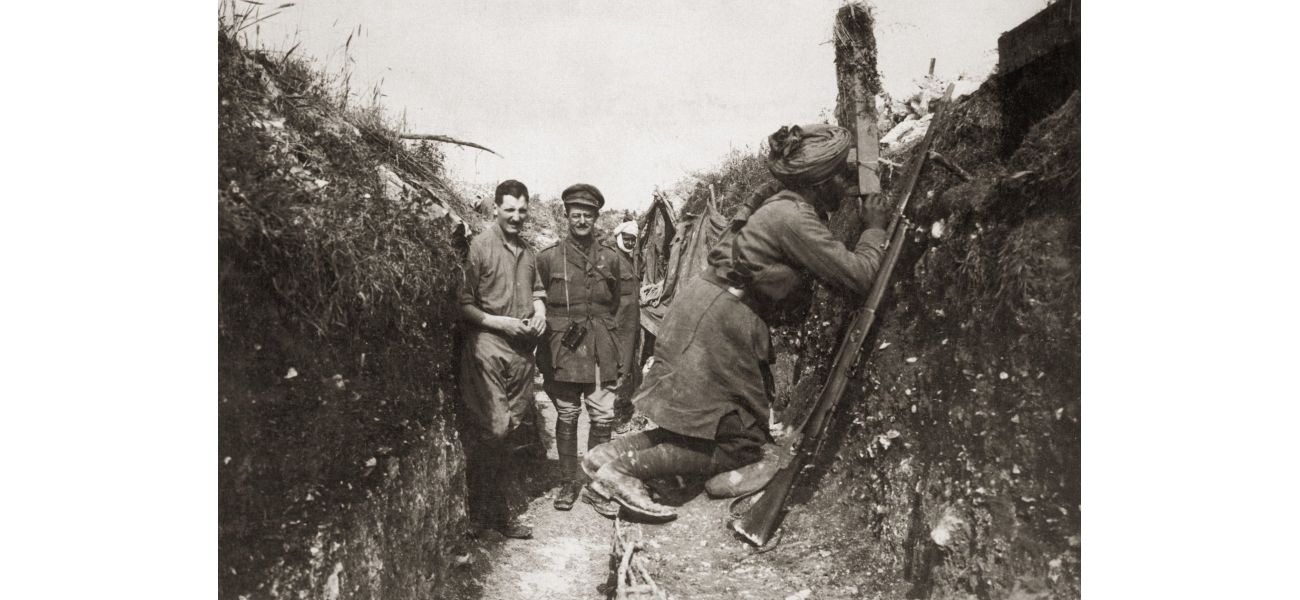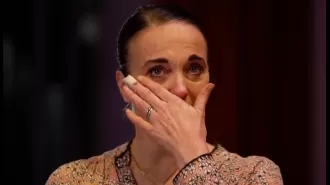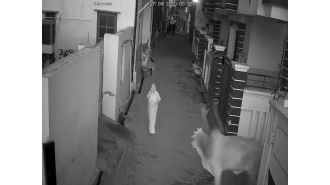A student's inquiry caused me to modify my approach to teaching history.
A 2015 discovery about trench food prompted a complete shift in my teaching approach to the world wars.
November 11th 2024.

As I stood in front of my class, discussing the food rations in the trenches of World War One, a curious 13-year-old student asked me a question that I had never considered before. "Miss, was there halal food in the trenches?" he asked. His question made me pause and think. I had been talking about tins of bully beef, but had I ever stopped to consider whether they were suitable for all soldiers, regardless of their religious beliefs?
I was slightly embarrassed to admit that I didn't know the answer, but I promised the student that I would find out. And that's when my journey began - a journey to uncover the underrepresented stories of war.
To my surprise, I discovered that not only were there halal options for Muslim soldiers, but Indian soldiers were also provided with ghee, spices, lentils, and atta to make chapatis. This revelation filled me with a mix of emotions - anger and disappointment that I had never learned about this in all my years of studying history, and also a sense of curiosity. What other hidden stories were there?
As a history teacher for over 15 years, I had always taught about the world wars in the traditional Eurocentric way - focusing on the causes, key battles, and the horrors of trench warfare. But now, armed with this newfound knowledge, I knew I had to change my approach. I couldn't just bolt on a separate lesson about Indian soldiers; I had to embed their stories into the curriculum.
I started to realize the significant contributions that colonial troops, from Indian soldiers to Caribbean pilots, had made in both world wars. In fact, in WW1, there were 4 million non-white non-European men who worked and fought for the allies, and in WW2, India provided the largest volunteer army the world had ever seen - 2.5 million strong.
As a historian, it is our responsibility to dig deep and uncover the realities of the past. And as a teacher, I knew that it was important to give my students a more complete and diverse understanding of history. If we only focus on the contributions of one group, we are not telling the whole story.
The more I delved into the hidden stories of war, the more I wanted to share them with my students. I no longer wanted to just teach them about the European perspective of the world wars; I wanted to show them the contributions of soldiers from all over the world. I included posters aimed at the "Young Men of the Bahamas" in my lessons about recruitment, and I showed my students a photograph of two Indian volunteers in their saris and Air Raid Precaution helmets.
It was fascinating to see my students' reactions to these stories and images. They were surprised to learn about the involvement of soldiers from different backgrounds and cultures, and it made them realize that there is always more to a story than what is commonly taught.
On a personal level, these hidden stories also surprised and resonated with me. As someone from a minority background, it can be challenging to connect with the history surrounding WW1 and WW2. Many of us do not have family histories related to these periods, and we do not have war medals or letters passed down through generations. But seeing images like the one of the Indian volunteers gave me a sense of pride and a connection to these events.
I now share these hidden stories on my Instagram account, History Corridor, in the hopes of reaching a wider audience and shedding light on the often overlooked contributions of soldiers from all over the world. It is essential to remember that even in familiar contexts like the Blitz, there are still hidden stories waiting to be discovered. And as historians, it is our duty to uncover and share these stories, enriching our understanding of the past.
As I stood in front of my class, teaching them about the food in the trenches of World War One, a curious question popped into my mind. "What other hidden stories were there?" I pondered, wondering what other untold tales lay beneath the surface of the history we were taught.
But then, a voice interrupted my thoughts. "Miss, was there halal food in the trenches?" A 13-year-old student asked, interrupting my lesson. It was 2015, and I was taken aback by the question. I realized that the tins of bully beef I was discussing may not have been suitable for this student. I didn't have an answer for him, but I promised to find out.
To my surprise, I discovered that not only was there halal food provided for Muslim soldiers, but Indian soldiers were also given ghee, spices, lentils, and atta to make their traditional dishes. This discovery left me feeling a mix of emotions – anger and disappointment that I, as someone who had studied history throughout school and university, had never come across this information before. It made me question, what other hidden stories were out there, waiting to be uncovered?
This experience marked the beginning of my journey to teach the underrepresented history of war. As I delved deeper into this topic, I realized that my own education had been lacking in this regard. Even though I had learned about the world wars in school and even visited the battlefields in Belgium and France, it wasn't until I was an adult that I became aware of the significant contributions of colonial troops, from Indian soldiers to Caribbean pilots, in both world wars.
The numbers spoke volumes – 4 million non-white non-European men had worked and fought for the allies in WW1, and India provided the largest volunteer army of 2.5 million soldiers in WW2. As a historian, it became my responsibility to dig deep and uncover the realities of the past, shedding light on the often overlooked contributions of these brave soldiers.
For over 15 years, I have been teaching history in a large secondary school, to students of all ages. Before my journey of exploring the hidden stories of war, I followed the traditional curriculum, teaching about the causes, key battles, and the harsh realities of trench warfare through a Eurocentric lens. I then added a separate lesson about Indian soldiers, based on my own research.
But after the revelation about halal food in the trenches, I knew I had to change my approach. I no longer wanted to "other" the experiences of these soldiers by teaching them in separate lessons. Instead, I wanted to integrate their stories into the lessons I already taught, enriching them with new perspectives. I started including posters aimed at the "Young Men of the Bahamas" alongside the classic "Your Country Needs You" images in lessons about recruitment in 1914.
Even familiar tales of evacuation and rationing on the home front during the Blitz took on a new meaning when I added one of my favorite images – two Indian volunteers wearing saris and Air Raid Precaution helmets. This image never failed to surprise my students, who were used to learning about WW2 in primary school but had never seen this particular photo before.
It was a reminder that even in well-known contexts like the Blitz, there were still hidden stories waiting to be discovered. Personally, it was also a surprise for me to come across such images. As someone from a minority background, it can be challenging to connect with the history surrounding WW1 and WW2, as we often don't have family histories or artifacts related to these periods.
Through my Instagram account, History Corridor, I share posts about these hidden stories, hoping to shed light on the often overlooked contributions of these soldiers. It's a small step towards teaching students the full story of war and honoring the bravery and sacrifices of all those who fought for their countries, regardless of their race or background.
I was slightly embarrassed to admit that I didn't know the answer, but I promised the student that I would find out. And that's when my journey began - a journey to uncover the underrepresented stories of war.
To my surprise, I discovered that not only were there halal options for Muslim soldiers, but Indian soldiers were also provided with ghee, spices, lentils, and atta to make chapatis. This revelation filled me with a mix of emotions - anger and disappointment that I had never learned about this in all my years of studying history, and also a sense of curiosity. What other hidden stories were there?
As a history teacher for over 15 years, I had always taught about the world wars in the traditional Eurocentric way - focusing on the causes, key battles, and the horrors of trench warfare. But now, armed with this newfound knowledge, I knew I had to change my approach. I couldn't just bolt on a separate lesson about Indian soldiers; I had to embed their stories into the curriculum.
I started to realize the significant contributions that colonial troops, from Indian soldiers to Caribbean pilots, had made in both world wars. In fact, in WW1, there were 4 million non-white non-European men who worked and fought for the allies, and in WW2, India provided the largest volunteer army the world had ever seen - 2.5 million strong.
As a historian, it is our responsibility to dig deep and uncover the realities of the past. And as a teacher, I knew that it was important to give my students a more complete and diverse understanding of history. If we only focus on the contributions of one group, we are not telling the whole story.
The more I delved into the hidden stories of war, the more I wanted to share them with my students. I no longer wanted to just teach them about the European perspective of the world wars; I wanted to show them the contributions of soldiers from all over the world. I included posters aimed at the "Young Men of the Bahamas" in my lessons about recruitment, and I showed my students a photograph of two Indian volunteers in their saris and Air Raid Precaution helmets.
It was fascinating to see my students' reactions to these stories and images. They were surprised to learn about the involvement of soldiers from different backgrounds and cultures, and it made them realize that there is always more to a story than what is commonly taught.
On a personal level, these hidden stories also surprised and resonated with me. As someone from a minority background, it can be challenging to connect with the history surrounding WW1 and WW2. Many of us do not have family histories related to these periods, and we do not have war medals or letters passed down through generations. But seeing images like the one of the Indian volunteers gave me a sense of pride and a connection to these events.
I now share these hidden stories on my Instagram account, History Corridor, in the hopes of reaching a wider audience and shedding light on the often overlooked contributions of soldiers from all over the world. It is essential to remember that even in familiar contexts like the Blitz, there are still hidden stories waiting to be discovered. And as historians, it is our duty to uncover and share these stories, enriching our understanding of the past.
As I stood in front of my class, teaching them about the food in the trenches of World War One, a curious question popped into my mind. "What other hidden stories were there?" I pondered, wondering what other untold tales lay beneath the surface of the history we were taught.
But then, a voice interrupted my thoughts. "Miss, was there halal food in the trenches?" A 13-year-old student asked, interrupting my lesson. It was 2015, and I was taken aback by the question. I realized that the tins of bully beef I was discussing may not have been suitable for this student. I didn't have an answer for him, but I promised to find out.
To my surprise, I discovered that not only was there halal food provided for Muslim soldiers, but Indian soldiers were also given ghee, spices, lentils, and atta to make their traditional dishes. This discovery left me feeling a mix of emotions – anger and disappointment that I, as someone who had studied history throughout school and university, had never come across this information before. It made me question, what other hidden stories were out there, waiting to be uncovered?
This experience marked the beginning of my journey to teach the underrepresented history of war. As I delved deeper into this topic, I realized that my own education had been lacking in this regard. Even though I had learned about the world wars in school and even visited the battlefields in Belgium and France, it wasn't until I was an adult that I became aware of the significant contributions of colonial troops, from Indian soldiers to Caribbean pilots, in both world wars.
The numbers spoke volumes – 4 million non-white non-European men had worked and fought for the allies in WW1, and India provided the largest volunteer army of 2.5 million soldiers in WW2. As a historian, it became my responsibility to dig deep and uncover the realities of the past, shedding light on the often overlooked contributions of these brave soldiers.
For over 15 years, I have been teaching history in a large secondary school, to students of all ages. Before my journey of exploring the hidden stories of war, I followed the traditional curriculum, teaching about the causes, key battles, and the harsh realities of trench warfare through a Eurocentric lens. I then added a separate lesson about Indian soldiers, based on my own research.
But after the revelation about halal food in the trenches, I knew I had to change my approach. I no longer wanted to "other" the experiences of these soldiers by teaching them in separate lessons. Instead, I wanted to integrate their stories into the lessons I already taught, enriching them with new perspectives. I started including posters aimed at the "Young Men of the Bahamas" alongside the classic "Your Country Needs You" images in lessons about recruitment in 1914.
Even familiar tales of evacuation and rationing on the home front during the Blitz took on a new meaning when I added one of my favorite images – two Indian volunteers wearing saris and Air Raid Precaution helmets. This image never failed to surprise my students, who were used to learning about WW2 in primary school but had never seen this particular photo before.
It was a reminder that even in well-known contexts like the Blitz, there were still hidden stories waiting to be discovered. Personally, it was also a surprise for me to come across such images. As someone from a minority background, it can be challenging to connect with the history surrounding WW1 and WW2, as we often don't have family histories or artifacts related to these periods.
Through my Instagram account, History Corridor, I share posts about these hidden stories, hoping to shed light on the often overlooked contributions of these soldiers. It's a small step towards teaching students the full story of war and honoring the bravery and sacrifices of all those who fought for their countries, regardless of their race or background.
[This article has been trending online recently and has been generated with AI. Your feed is customized.]
[Generative AI is experimental.]
0
0
Submit Comment





